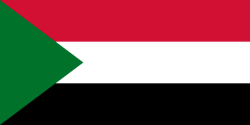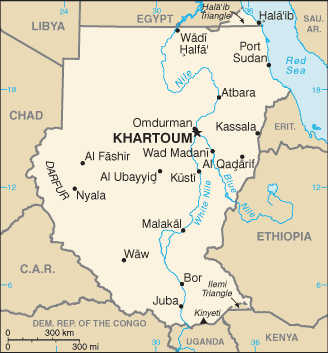Republic of the Sudan
Related Categories:
 Flag of Sudan
Flag of SudanThree equal horizontal bands of red (top), white, and black with a green isosceles triangle based on the hoist side. |
 Sudan - Fotw
Sudan - FotwRed stands for struggle and the martyrs of the Sudan and the Great Arab Land.
www.fotw.us/
Archaeological evidence has confirmed that the area in the north of Sudan was inhabited at least sixty thousand years ago. A settled culture appeared in the area around 8000 BCE, living in fortified mud-brick villages, where they subsisted on hunting and fishing, as well as grain gathering and cattle herding.
en.wikipedia.org/
Sudanís population is one of the most diverse on the African continent. There are two distinct major cultures--"Arab" and black African--with hundreds of ethnic and tribal subdivisions and language groups, which make effective collaboration among them a major political challenge.
The northern states cover most of the Sudan and include most of the urban centers. Most of the 22 million Sudanese who live in this region are Arabic-speaking Muslims, though the majority also uses a non-Arabic mother tongue--e.g., Nubian, Beja, Fur, Nuban, Ingessana, etc. Among these are several distinct tribal groups: the Kababish of northern Kordofan, a camel-raising people; the Jaíalin and Shaigiyya groups of settled tribes along the rivers; the semi-nomadic Baggara of Kordofan and Darfur; the Hamitic Beja in the Red Sea area and Nubians of the northern Nile areas, some of whom have been resettled on the Atbara River; and the Negroid Nuba of southern Kordofan and Fur in the western reaches of the country.
The southern region has a population of around 6 million and a predominantly rural, subsistence economy. Except for a ten-year hiatus, southern Sudan has been embroiled in conflict, resulting in major destruction and displacement since independence. More than 2 million people have died, and more than 4 million are internally displaced or have become refugees as a result of the civil war and war-related impacts. The southern Sudanese practice mainly indigenous traditional beliefs, although Christian missionaries have converted some. The south also contains many tribal groups and many more languages than are used in the north. The Dinka--whose population is estimated at more than 1 million--is the largest of the many black African tribes of the Sudan. Along with the Shilluk and the Nuer, they are among the Nilotic tribes. The Azande, Bor, and Jo Luo are "Sudanic" tribes in the west, and the Acholi and Lotuhu live in the extreme south, extending into Uganda.
In 2006, Sudanís population reached an estimated 41 million. A new census is planned for 2007. The population of metropolitan Khartoum (including Khartoum, Omdurman, and North Khartoum) is growing rapidly and ranges from 6-7 million, including around 2 million internally displaced persons from the former southern war zone as well as western and eastern regions affected by drought, conflict, and marginalization. In Darfur, there are an estimated 1.8 million internally displaced persons and another 220,000 refugees in neighboring Chad--200,000 in 12 camps and 20,000 in the border area.
www.state.gov/r/
Introduction
About
Contact
Symbols in The News
Interpret this Symbol
AAC
African
AI
Alchemy
Alphabets
Ancient
Animal Symbolism
Architecture
Art
Articles
Astrology
Baha'i
Blissymbolics
Blueprint Symbols
Buddhist
Celtic Symbols
Cemetery
Chinese Symbols
Christian
Circle
City
Codes
Color
Conlangs
Crop Circles
Danger
Da Vinci Code
Designing Logos
Dictionaries
Dreams
Education
Egyptian Symbols
Electrical
Emoticons
Find Images
Fonts
Food
Fraternity
Hamsa
Healing
Heraldry
Hermetic
Highway Signs
Hindu
History
Hobo
Holiday
Icons
iConji
Islamic
Jain Symbols
Japanese, Kanji
Jewish
Justice
Law
Literary Symbolism
Mandalas
Map
Masonic
Math, Number
Meaning of Names
Medical
Middle East
Military
Miscellaneous
Money
Music
Mythology
Native American
Playing Cards
Power
Psychology
QiQiiKhu
Reiki
Religious
Runes, Norse
Sacred Geometry
Scientific
Science Fiction
Sorority
Sports
Symbols in the News
Tattoos
ThirteenSymbols
Tree of Life
Ursprache
Videos
Visual Languages
Weather
Web Codes
Wicca
Words
Writing Systems
Braille
Coinherence
Coptic
Cuneiform
Easter Island
Etruscan
Happy Human
Hebrew
Kokopelli
Linear B
Lotus
Love Symbols
Mandorla
Moon Alphabet
Nine Pointed Star
Om
Oz
Phonetic
Scarab Beetle
Silent
Theosophy
Unifon
About
Contact
Symbols in The News
Interpret this Symbol
AAC
African
AI
Alchemy
Alphabets
Ancient
Animal Symbolism
Architecture
Art
Articles
Astrology
Baha'i
Blissymbolics
Blueprint Symbols
Buddhist
Celtic Symbols
Cemetery
Chinese Symbols
Christian
Circle
City
Codes
Color
Conlangs
Crop Circles
Danger
Da Vinci Code
Designing Logos
Dictionaries
Dreams
Education
Egyptian Symbols
Electrical
Emoticons
Find Images
Fonts
Food
Fraternity
Hamsa
Healing
Heraldry
Hermetic
Highway Signs
Hindu
History
Hobo
Holiday
Icons
iConji
Islamic
Jain Symbols
Japanese, Kanji
Jewish
Justice
Law
Literary Symbolism
Mandalas
Map
Masonic
Math, Number
Meaning of Names
Medical
Middle East
Military
Miscellaneous
Money
Music
Mythology
Native American
Playing Cards
Power
Psychology
QiQiiKhu
Reiki
Religious
Runes, Norse
Sacred Geometry
Scientific
Science Fiction
Sorority
Sports
Symbols in the News
Tattoos
ThirteenSymbols
Tree of Life
Ursprache
Videos
Visual Languages
Weather
Web Codes
Wicca
Words
Writing Systems
Braille
Coinherence
Coptic
Cuneiform
Easter Island
Etruscan
Happy Human
Hebrew
Kokopelli
Linear B
Lotus
Love Symbols
Mandorla
Moon Alphabet
Nine Pointed Star
Om
Oz
Phonetic
Scarab Beetle
Silent
Theosophy
Unifon
